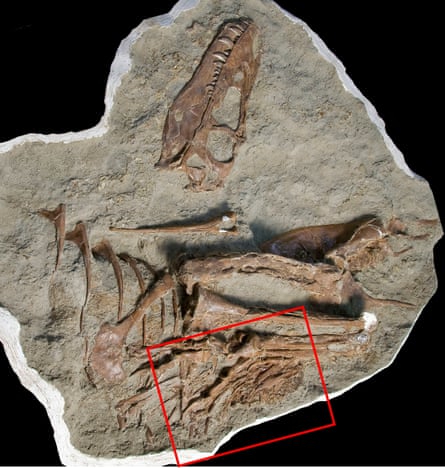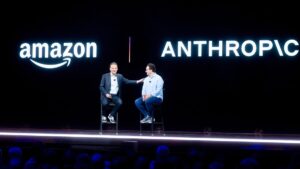A remarkable fossil preserving the last meal of a young tyrannosaur has been discovered in Canada, revealing the dinosaur had a taste for prehistoric fast food.
While tyrannosaurs were some of the most fearsome dinosaurs to roam the planet, with adults boasting massive bodies, huge heads and bone-crushing bites, juveniles were rather more puny, with long, skinny legs, blade-like teeth and narrow skulls.
The transformation has long been thought to be associated with a shift in diet as the tyrannosaurs matured and required more energy: while evidence including bite marks on bones has suggested adults hunted and feasted upon enormous herbivores, such as duck-billed and horned dinosaurs, youngsters did not have the dental apparatus to tackle such prey.
But just what the juveniles did munch on has been something of a mystery.
Now a spectacular fossil featuring the preserved stomach contents of a young tyrannosaur has offered a rare insight into their diet.
“This is really the first solid evidence that we have of what the diet or feeding behaviour was in a juvenile tyrannosaur,” said Dr Darla Zelenitsky, the co-author of the study at the University of Calgary.
Thought to date to about 75m years ago, the fossil of the young Gorgosaurus libratus was discovered in the badlands of Dinosaur Provincial Park, Canada, in 2009 by Darren Tanke, a technician working at the Royal Tyrrell Museum of Palaeontology.
The team say the young tyrannosaur had weighed about 350kg, with analysis of growth rings in the fossilised bones suggesting it died young, at five to seven years old.
But it didn’t die hungry.
“It was during the preparation process in late 2010 that Darren noticed small knuckle bones that were protruding out of the ribcage of the tyrannosaur,” said Dr François Therrien, the curator of dinosaur palaeoecology at the Royal Tyrrell Museum and co-author of the research.
Writing in the journal Science Advances, the team report that inside the ribcage they discovered the remains of two juvenile citipes: turkey-sized creatures with a parrot-like head that would have been speedy on their feet, rather like an emu.
Differences in the extent of stomach acid damage suggested the citipes were consumed in two separate sittings. However, the remains were largely limited to the hind legs, suggesting the young tyrannosaur did not eat all of its prey.
“This juvenile tyrannosaurus seems to have had an appetite for drumsticks of citipes,” said Zelenitsky, adding that one possibility is that the legs were the meatiest part of the prey, with the skull of the young gorgosaurus enabling precision feeding.
While the team said it was unclear how the tyrannosaur died, it appears to have perished within a week of its last meal.
The discovery is the first time the fossil of a tyrannosaur has been found with the contents of its stomach preserved. And there is another bonus to the find.
“The legs present in the stomach represent the most complete citipes skeleton known,” said Therrien.

Prof Stephen Brusatte, a palaeontologist at the University of Edinburgh, who is not involved in the work, said the fossil was direct evidence of what a tyrannosaur was eating.
“Not guesswork or a series of assumptions based on interpretation of bite marks or coprolites – fossil faeces – but actual direct in-the-gut evidence,” he said. “This is a tyrannosaur’s last meal, preserved in stone.”
Brusatte said the fossil supported the idea that tyrannosaurs changed their diets as they got older, shifting from small to huge prey.
While Brusatte added the insights make intuitive sense, he said it was not inevitable, noting an alternative possibility was that young tyrannosaurs simply feasted on prey killed by adults.
“But that doesn’t seem to be the case here – the little tyrannosaurs ate little prey, so they probably actively hunted their own food and changed the prey they targeted as they got bigger,” he said. “This means that tyrannosaurs filled different roles in the food web as they grew up, which is pretty neat.”





